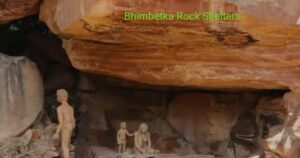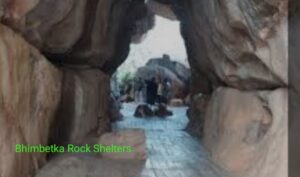Nestled in the dense forests of Madhya Pradesh, India, the “Bhimbetka Rock Shelters” stand as a testimony to prehistoric human existence. Recognized as a UNESCO World Heritage Site in 2003, these rock shelters are a treasure trove of ancient art and archaeology, dating back tens of thousands of years. Bhimbetka not only offers a glimpse into the lives of our ancestors but also serves as a symbol of the cultural and historical wealth of India. This blog post delves into the significance, history, and art of the Bhimbetka Rock Shelters, unraveling the mysteries they hold.

1. Bhimbetka Rock Shelters: Historical Significance
The Bhimbetka Rock Shelters were discovered in 1957 by Indian archaeologist Dr. Vishnu Wakankar, and since then, they have fascinated historians and archaeologists around the world. The caves are believed to have been inhabited by humans from the Paleolithic Age to the Mesolithic and even early historical times, covering an impressive span of human history.
Dating back more than 100,000 years, these rock shelters offer a unique insight into the development of human life on the Indian subcontinent. Early human ancestors, including Homo erectus, are thought to have used these shelters for habitation. The site not only shows how humans adapted to their environment but also showcases the evolution of early human tools and art forms.
The “Bhimbetka Rock Shelters” serve as a vital archaeological record, revealing early human life in one of the most ancient parts of the world. As a prehistoric site, Bhimbetka connects the modern world with our ancient past, offering evidence of early human culture and survival strategies.
2. Bhimbetka Rock Shelters:The Rock Art of Bhimbetka
One of the most captivating aspects of the Bhimbetka Rock Shelters is the “prehistoric rock art” found on the cave walls. These paintings, which are believed to date from the Upper Paleolithic period to the medieval period, display a wide range of themes, techniques, and artistic styles.
The paintings predominantly feature animals such as bison, tigers, lions, and boars, reflecting the close relationship between early humans and their environment. Hunting scenes, featuring humans armed with spears, bows, and arrows, are a common motif. There are also depictions of everyday life—gathering food, dancing, and religious rituals.
The techniques used in the paintings are equally varied. Some were created using natural pigments like red ochre, while others employed more sophisticated techniques involving multiple layers and intricate patterns. The vibrant colors and fluidity of the figures indicate that early humans had a deep understanding of the materials and tools at their disposal.
The “Bhimbetka rock art” is more than just beautiful to look at; it provides valuable insights into prehistoric human culture. The themes of the paintings suggest that the early inhabitants of Bhimbetka had a rich cultural life, with art, religion, and community activities playing a significant role in their society.

3.Cultural and Anthropological Relevance
The Bhimbetka Rock Shelters are not just significant for their artistic value—they are also crucial for understanding early human culture and social organization. These rock shelters likely served as a protective habitat, a space for social interaction, and even a spiritual or religious center for early humans.
From an “anthropological perspective”, the shelters provide evidence of early human settlements in India. Archaeological excavations have uncovered stone tools, pottery, and other artifacts that reveal how early humans adapted to their environment. The shelters’ strategic location near water sources and forested areas suggests that they were used for hunting, gathering, and shelter for extended periods.
Additionally, the art found in Bhimbetka points to a strong spiritual component in early human life. Many of the paintings depict scenes of rituals and ceremonies, suggesting that these shelters may have been a site for religious activities. The human figures in the paintings are often shown in large groups, emphasizing the communal nature of these rituals.
The “Bhimbetka Rock Shelters” thus offer a rare opportunity to study early human civilization. They allow researchers to explore how humans evolved culturally and socially over thousands of years, making them a vital piece of our shared human heritage.
4.Geological Significance
Beyond their archaeological and cultural importance, the Bhimbetka Rock Shelters also hold great “geological significance”. The rock formations themselves are a marvel of nature, formed over millions of years. The shelters are situated on the edge of the Vindhyan mountain range, and their formation is the result of natural processes like weathering and erosion.
The unique geological features of Bhimbetka, including the layered rocks and natural cave formations, have made it an ideal location for human habitation. The shelters provided protection from harsh weather conditions while offering a vantage point for hunting and gathering.
The study of the geology of Bhimbetka has also helped scientists understand the “earth’s history” during different geological periods. The sandstone formations offer clues to the prehistoric climate, landscape, and natural resources of the region, making Bhimbetka a site of interest not only for archaeologists but also for geologists and naturalists.

5.Visitor Information
For those who wish to experience the awe-inspiring history and beauty of the “Bhimbetka Rock Shelters” firsthand, visiting the site is relatively easy. Located about 45 kilometers south of Bhopal, the capital of Madhya Pradesh, Bhimbetka is well-connected by road and can be accessed from major cities like Bhopal or Hoshangabad.
The best time to visit Bhimbetka is during the winter months, between October and March, when the weather is pleasant and ideal for exploring. Visitors can tour the rock shelters, marvel at the ancient paintings, and take in the breathtaking views of the surrounding landscape.
Nearby attractions include the “Sanchi Stupa” and the “Bhojpur Temple”, both of which are important historical and religious sites. The Bhimbetka complex is also part of the “Ratapani Wildlife Sanctuary”, making it a perfect destination for nature enthusiasts.
When visiting Bhimbetka, it is important to respect the site’s historical and cultural value. Preservation efforts are underway to protect the rock art and the surrounding environment, so responsible tourism is encouraged.
Conclusion:
The “Bhimbetka Rock Shelters” offer an unparalleled glimpse into the lives of our prehistoric ancestors. Through their art, culture, and tools, we can better understand how early humans lived, interacted with their environment, and expressed themselves. Bhimbetka stands as a bridge between the past and the present, reminding us of the rich heritage we have inherited and the importance of preserving it for future generations.
If you’re passionate about history, culture, or nature, Bhimbetka should be on your travel bucket list. Explore this ancient site and witness the legacy of the first humans who walked the Indian subcontinent.
FAQ:
1.What is Bhimbetka rock shelters famous for?
2.Where is Bhimbetka situated?
3.Where are rock shelters found in India?
4.What did the cave paintings at Bhimbetka reveal?
5.Where is Bhimbetka located
6.Bhimbetka cave paintings
7.Bhimbetka cave paintings PDF
8.10 lines on Bhimbetka
9.Bhimbetka rock shelters images
10.How many bhimbetka rock shelters

